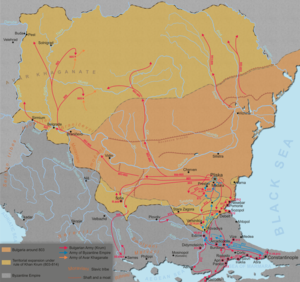Battle of Versinikia
| Battle of Versinikia | |||||||
|---|---|---|---|---|---|---|---|
| Part of the Byzantine-Bulgarian Wars | |||||||
 Bulgaria under Khan Krum including the most important campaigns and battles |
|||||||
|
|||||||
| Belligerents | |||||||
| Bulgarian Empire | Byzantine Empire | ||||||
| Commanders and leaders | |||||||
| Khan Krum | Michael I Rangabe | ||||||
| Strength | |||||||
| ~12,000 men | ~26,000 men | ||||||
| Casualties and losses | |||||||
| Few | Heavy | ||||||
The Battle of Versinikia (Bulgarian: Битката при Версиникия, Greek: Μάχη της Βερσινικίας) was fought in 813 between the Byzantine Empire and the Bulgarian Empire, near the city of Adrianople (Edirne) in contemporary Turkey.
Despite being vastly outnumbered the Bulgarians were victorious, resulting in the dethroning of Michael I Rangabe (811-813) by Leo V the Armenian. The battle was a major success and further strengthened the Bulgarian position after their decisive victory over Nicephorus I two years earlier. In fact, after the battle they de facto took control of the whole of Eastern Thrace (until the Byzantine–Bulgarian Treaty of 815) with the exception of a few castles that remained in Byzantine control. For the first time in the Bulgarian history, the way to Constantinople was opened. Unfortunately for them, the great Khan Krum died in the height of the preparation for the final siege of the Byzantine capital on 13 April 814.
After the great victory over the Byzantine army of emperor Nicephorus I in the battle of Pliska in 811, the Byzantine Empire found itself in a really difficult situation. Nicephorus' son (and legitimate heir) Staurakios, who was seriously wounded in the battle, was deposed in the autumn of the same year, after a palace coup d’état. Michael I Rangabe, curopalates (supervisor of the palace) during the reign of Nicephorus I, was proclaimed emperor.
...
Wikipedia
